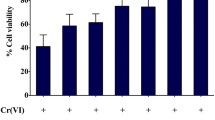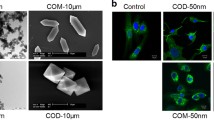Abstract
The purpose of the study was to test whether the antioxidants oligomeric proanthocyanidins (OPCs) could provide protection against oxalate and calcium oxalate monohydrate crystals (COM) toxicity in HK-2 cells. Four groups were chosen for the study: negative control group, positive control group (COM + oxalate), OPCs group (OPCs + COM + oxalate), Vit E group (Vit E + COM + oxalate). HK-2 cells were exposed for 4, 8, 12 and 24 h. The activity of HK-2 cell was assessed by MTT. Cellular injury was assessed by activity of Na+/K+ ATP enzyme. Peroxidation level was assessed by malondialdehyde (MDA) content in medium and activity of superoxide dismutase (SOD). Morphological changes of HK-2 cell after exposed for 4 and 12 h in each group were observed under Transmission electron microscope (TEM). The effects of OPCs and VitE on oxalate- and COM-exposed cells were tested. After exposed to oxalate and COM crystals, activity of cells, Na+/K+ ATP enzyme and SOD enzyme showed a significant reduction, and MDA content in medium was significantly increased. OPCs group: the addition of OPCs significantly increased activity of cell, SOD and Na+/K+ ATP enzyme while MDA content was significantly decreased compared with the positive control group. VitE group: compared with the positive control group, activity of HK-2 cell, Na+/K+ ATP enzyme was not significantly changed while SOD activity was restored, and MDA content was significantly decreased after the addition of Vit E. Morphological structure of HK-2 cell was extremely changed as observed under TEM after exposure to high level of COM crystals and oxalate. After the addition of OPCs or Vit E, amounts of cells with vacuoles formed in cytoplasms, karyotheca dissolved and nucleolus disappeared were less than in positive control group. The morphological structure changing in OPCs group was slighter than that in Vit E group. OPCs and vitamin E administration may prevent oxalate- and COM-mediated peroxidative injury, restoring intracellular antioxidant enzyme activity. The protection rendered by OPCs was greater than that of vitamin E.









Similar content being viewed by others
References
Strope SA, Wolf JS Jr, Hollenbeck BK (2010) Changes in gender distribution of urinary stone disease. Urology 75(3):543–546
Khan SR (2005) Hyperoxaluria induced oxidative stress and antioxidants for renal protection. Urol Res 33(5):349–357
Verkoelen CF, Schepers MS, van Ballegooijen ES, Bangma CH (2005) Effects of luminal oxalate or calcium oxalate on renal tubular cells. Urol Res 33(5):321–328
Zi SX, Ma HJ, Li Y et al (2009) Oligomeric proanthocyanidins from grape seeds effectively inhibit ultraviolet-induced melanogenesis of human melanocytes in vitro. Int J Mol Med 23(2):197–204
Thamilselvan S, Khan SR, Menon M (2002) Oxalate and calcium oxalate mediated free radical toxicity in renal epithelial cells: effect of antioxidants. Urol Res 31(1):3–9
Lieske JC, Leonard R, Toback FG (1995) Adhesion of calcium oxalate monohydrate crystals to renal epithelial cells is inhibited by specific unions. Am J Physiol 268(3):F604–F612
Hackett RL, Shevock PN, Khan SR (1995) Alteration in MDCK and LLC-PK1 cells exposed to oxalate and calcium oxalate monohydrate crystals. Scanning Microsc 9(2):587–596
Scheid C, Koul H, Hill WA et al (1996) Oxalate toxicity in LLC-PK1 cells: role of free radicals. Kidney Int 49(2):413–419
Sutherland BA, Rahman RM, Appleton I (2006) Mechanism of action of green tea catechins, with a focus on ischemia-induced neurodegeneration. J Nutr Biochem 17(5):291–306
Khan SR (1995) Heterogenous nucleation of calcium oxalate crystals in mammalian urine. Scanning Microsc 9(2):597–614
Jonassen JA, Cao LC, Honeyman T, Scheid CR (2003) Mechanisms mediating oxalate-induced alterations in renal cell functions. Crit Rev Eukaryot Gene Expr 13(1):55–72
Thamilselvan S, Byer KJ, Hackett RL, Khan SR (2000) Free radical scavengers, catalase and superoxide dismutase provide protection from oxalate-associated injury to LLC-PK1 and MDCK cells. J Urol 164(1):224–229
Khan SR (2004) Role of renal epithelial cells in the initiation of calcium oxalate stones. Nephron Exp Nephrol 98(2):e55–e60
Schepers MS, Van Balleqooijen ES, Bangma CH, Verkoelen CF (2005) Crystals cause acute necrotic cell death in renal proximal tubule cells, but not in collecting tubule cells. Kidney Int 68(4):1543–1553
Hackett RL, Shevock PN, Khan SR (1994) Madin-Darby canine kidney cells are injured by exposure to oxalate and to calcium oxalate crystals. Urol Res 22(4):197–203
Koul HK, Menon M, Chaturvedi LS et al (2002) COM crystals activate the p38 mitogen-activated protein kinase signal transduction pathway in renal epithelial cells. J Biol Chem 277(39):36845–36852
Lieske JC, Toback FG (1996) Interaction of urinary crystals with renal epithelial cells in the pathogenesis of nephrolithiasis. Semin Nephrol 16(5):458–473
Thamilselvan S, Hackett RL, Khan SR (1999) Cells of proximal and distal tubular origin responds differently to challenges of oxalate and calcium oxalate crystals. J Am Soc Nephrol 10:S452–S456
Halliwell B, Gutteridge JMC (1989) Protection against oxidants in biological systems, 2nd edn. Clarendon Press, Oxford, p 87
Witting LA (1980) In: Pryor WA (ed) Free radicals in biology, vol 4. Academic Press, New York, p 295
Kagan VE, Serbinova EA, Packer L (1990) Recycling and antioxidant activity of tocopherol homologs of differing hydrocarbon chain lengths in liver microsomes. Arch Biochem Biophys 282(2):221–225
Khand FD, Gordge MP, Robertson WG, Noronha-Dutra AA, Hothersall JS (2002) Mitochondrial superoxide production during oxalate-mediated oxidative stress in renal epithelial cells. Free Radic Biol Med 32(12):1339–1350
Bagchi D, Krohn RL, Bagchi M et al (1997) Oxygen free radical scavenging abilities of vitamins C and E, and a grape seed proanthocyanidin extract in vitro. Res Commun Mol Pathol Pharmacol 95(2):179–189
Silva J, Rigaud J, Cheynier V et al (1991) Procyanidin dimers and trimers from grape seeds. Phytochemistry 30:1259–1264
Frankel EN, Kanner J, German JB, Parks E, Kinsella JE (1993) Inhibition of oxidation of human low-density lipoprotein by phenolic substances in red wine. Lancet 341(8843):454–457
Bagchi D, Garg A, Krohn R et al (1998) Protective effects of grape seed proanthocyanidins and selected antioxidants against TPA-induced hepatic and brain lipid peroxidation and DNA fragmentation, and peritoneal macrophage activation in mice. Gen Pharmacol 30(5):771–776
Hatano T, Yasuhara T, Yoshihara R, Agata I, Noro T, Okuda T (1990) Effects of interaction of tannins with coexisting substances. VII. Inhibitory effects of tannins and related polyphenols on xanthine oxidase. Chem Pharm Bull 38(5):1224–1229
Verin MMP, Vilda A, Maurin JF (1978) Therapeutic essay. Retinopathy and OPC. Bord Med 11:1467–1473 (in French)
Author information
Authors and Affiliations
Corresponding author
Ethics declarations
Conflict of interest
The authors declare that they have no financial and personal relationships with other people or organizations that can inappropriately influence their work, there is no professional or other personal interest of any nature or kind in any product, service and/or company that could be construed as influencing the position presented in, or the review of, the entitled manuscript.
Rights and permissions
About this article
Cite this article
Wang, S., Du, P., Zhang, N. et al. Oligomeric proanthocyanidins protect against HK-2 cell injury induced by oxalate and calcium oxalate monohydrate crystals. Urolithiasis 44, 203–210 (2016). https://doi.org/10.1007/s00240-015-0826-9
Received:
Accepted:
Published:
Issue Date:
DOI: https://doi.org/10.1007/s00240-015-0826-9




